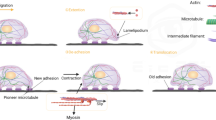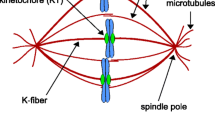Abstract
It is well known that cytoskeleton and karyoskeleton proteins are associated with changes in cell shape and with the rearrangement of the dynamic structures involved in cell division and motility. In higher vertebrates, there are three major skeletal protein groups: microfilaments, microtubules and intermediate filaments, each representing a multigene family. Some of these skeletal proteins are expressed in a temporally- and spatially-specific fashion, and they establish cell-specific cytoplasmic and nucleoplasmic organization during development. Here we report the cDNA cloning of a novel 60 kDa skeletal protein from mouse spermatocytes, termed MNS 1 (meiosis-specific nuclear structural protein), whose computer-predicted protein configuration indicates long α-helical coiled-coil domains flanked by non-helical terminal domains. Functional characterization of MNS1 by ectopic expression in culture cells indicated that it is a detergent-and high salt-resistant skeletal protein which is involved in organization of the nuclear or perinuclear architecture. The MNS1 protein is specifically expressed at the pachytene stage during spermatogenesis, so that its function may involve the determination and maintenance of the appropriate nuclear morphology during meiotic prophase.
Similar content being viewed by others
References
Aebi U, Cohn J, Buhle L (1986) The nuclear lamina is a meshwork of intermediate-type filaments.Nature 323: 560–564.
Bellve AR, Cavicchia JC, Millette CF, O'Brien DA, Bhatnagar YM, Dym M (1977) Spermatogenic cells of the prepubital mouse.J Cell Biol 74: 68–85.
Bellve AR, O'Brien DA (1983) The mammalian spermatozoen: Structure and temporal assembly. In: Hartman, ed.Mechanisms and Control of Animal Fertilization. New York, Academic Press, pp. 55–137.
Bellve AR, Chandrika R, Barth A (1990) Temporal expression, polar distribution and transition of an epitope domain in the perinuclear theca during mouse spermatogenesis.J Cell Sci 96: 745–756.
Bellve AR, Chandrika R, Martonova YS, Barth AH (1992) The perinuclear matrix as a structural element of the mouse sperm nucleus.Biol Reprod 47: 451–465.
Chandley AC, Hotta Y, Stern H (1977) Biochemical analysis of meiosis in the male mouse.Chromosoma 62: 243–253.
Chemes HE, Fawcett DW, Dym M (1978) Unusual features of the nuclear envelope in human spermatogenic cells.Anat Rec 192: 493–512.
Chou PY, Fasman GD (1978) Empirical predictions of protein conformation.Annu Rev Biochem 47: 251–276.
Counce SJ, Meyer GF (1973) Differentiation of the synaptonemal complex and the kinetochore inLocusta spermatocytes studied by whole mount electron microscopy.Chromosoma 44: 231–253.
Dwyer N, Blobel G (1976) A modified procedure for the isolation of a pore complex-lamina fraction from rat liver nuclei.J Cell Biol 70: 581–591.
Fawcett DW, Chemes HE (1979) Changes in distribution of nuclear pore during differentiation of the male germ cells.Tissue Cell 11: 147–162.
Fey EG, Wan KM, Penman S (1984) Epithelial cytoskeletal framework and nuclear matrix-intermediate filament scaffold: three-dimensional organization and protein composition.J Cell Biol 98: 1973–1984.
Franke WW (1987) Nuclear lamins and cytoplasmic intermediate filament proteins: a growing multigene family.Cell 48: 3–4.
Furukawa K, Yamaguchi Y, Ogawa E, Shigesada K, Satake M, Ito Y (1990) A ubiquitous repressor interacting an F9 cell-specific and its functional suppression by differentiated cell-specific positive factors.Cell Growth Diff 2: 135–147.
Furukawa K, Hotta Y (1993) cDNA cloning of a germ cell specific lamin B3 from mouse spermatocytes and analysis of its function by ectopic expression in somatic cells.EMBO J 12: 97–106.
Gard D, Bell PB, Lazarides E (1979) Coexistence of desmin and the fibroblastic intermediate filament subunit in muscle and non muscle cells: identification and cooperative peptide analysis.Proc Natl Acad Sci USA 76: 3894–3898.
Geisler N, Kaufman E, Weber K (1982) Protein-chemical characterization of three structurally distinct domains along the protofilament unit of desmin 10 nm filaments.Cell 30: 277–286.
Gerace L, Blum A, Blobel G (1978) Immunochemical localization of the major polypeptides of the nuclear pore complexlamina fraction.J Cell Biol 79: 546–566.
Harlow E, Lane D (1988)Antibodies. A Laboratory Manual. New York. Cold Spring Harbor Laboratory Press.
Heyting C, Moens PB, Raamsdonk WV, Dietrich AJJ, Vink ACG, Redeker EJW (1987) Identification of two major components of the lateral elements of synaptonemal complex of the rat.Eur J Cell Biol 43: 148–154.
Holt WV, Moor HDM (1984) Ultrastructural aspects of spermatogenesis in the common marmoset.J Anat 138: 175–188.
Holtz D, Tanaka RA, Hartwig J, McKeon F (1989) The CaaX motif of lamin A functions in conjunction with the nuclear localization signal to target assembly to the nuclear envelope.Cell 59: 969–977.
Hotta Y, Tabata S, Stern H (1984) Replication and nicking of zygotene DNA sequences.Chromosoma 90: 243–253.
Kitten GT, Nigg EA (1991) The Caax motif is required for isoprenylation, carboxy methylation, and nuclear membrane association of lamin B2.J Cell Biol 113: 13–23.
Kolodziej P, Young A (1989) RNA polymerase II subunit RPB3 is an essential component of the mRNA transcription apparatus.Mol Cell Biol 9: 5387–5394.
Kozak M (1984) Compilation and analysis of sequence upstream from the translational startsite in eukaryotic mRNAs.Nucleic Acids Res 12: 857–872.
Laemmli UK (1970) Cleavage of structural proteins during the assembly of the head of bacteriophage T4.Nature 227: 680–685.
Lehtonen E, Ordonez G, Reima I (1988) Cytoskeleton in preimplantation mouse development.Cell Diff 24: 165–178.
Lendahl U, Zimmerman LB, Mckay DG (1990) CNS stem cells express a new class of intermediate filament protein.Cell 60: 585–595.
Loewinger L, McKeon F (1988) The redistribution of a conserved nuclear envelope protein during cell cycle suggests a pathway for chromosome condensation.EMBO J 7: 2301–2309.
Longo FJ, Krohne G, Franke WW (1987) Basic protein of the perinuclear theca of mammalian spermatozoa and spermatids: a novel class of cytoskeletal elements.J Cell Biol 105: 1105–1120.
Maul GG, French T, Bechtol KB (1986) Identification and redistribution of lamins during nuclear differentiation in mouse spermatogenesis.Dev Biol 105: 68–77.
Meuwissen RLJ, Offenberg HH, Dietrich AJJ, Riesewijk S, Israel M, Heyting C (1992) A coiled-coil related protein specific for synapsed regions of meiotic prophase chromosomes.EMBO J 11: 5091–5100.
Moss SB, Burnham BL, Bellve AN (1993) The differential expression of lamin epitopes during mouse spermatogenesis.Mol Reprod Dev 34: 164–174.
Mukohata Y, Ihara K, Yoshida M, Konishi J, Sugiyama Y, Yoshida M (1987) The halobacterial H+-translocating ATP synthase related to the eukaryotic anion-sensitive H+-ATPase.Arch Biochem Biophys 259: 650–653.
Niman HL, Houghten RA, Walker LE, Reisfeld RA, Wilson IA, Hogle JM, Lerner RA (1983) Generation of protein-reactive antibodies by short peptides is an event of high frequency: Implications for the structural basis of immune recognition.Proc Natl Acad Sci USA 80: 4949–4953.
Pruslin FH, Rodman TC (1985) Proteins of demembraned mouse sperm heads.J Biol Chem 260: 5654–5659.
Rose GD (1978) Prediction of chain turns in globular proteins on a hydrophobic basis.Nature 272: 586–590.
Satake M, Luftig RB (1983) Comparative immunofluorescence of murine leukemia virus-derived membrane-associated antigens.Virology 124: 259–273.
Seed B (1987) An LFA-3 cDNA encodes a phospholipid linked membrane protein homologous to its receptor CD2.Nature 329: 840–842.
Smith A, Benavente R (1992a) Identification of a structural protein component of rat synaptonemal complexes.Exp Cell Res 198: 291–297.
Smith A, Benavente R, (1992b) Identification of a short nuclear lamin protein selectively expressed during meiotic stage of rat spermatogenesis.Differentiation 52: 55–60.
Smith DB, Johnson KS (1988) Single-step purification of polypeptides expressed inE. coli as fusions with glutathione S-transferase.Gene 67: 31–40.
Spiegelman BM, Frank M, Green H (1983) Molecular cloning of mRNA from 3T3 adipocytes.J Biol Chem 258: 10083–10089.
Staufenbiel M, Deppert W (1984) Preparation of nuclear matrices from cultured cells: subfractionation of nucleiin situ.J Cell Biol 98: 1886–1894.
Stern H (1991) Meiosis. In: Adolph KW, ed.Chromosomes: Eukaryotic, Prokaryotic and Viral. Boca Raton Florida, CRC Press,2: 2–37.
Steinert PM, Rice RH, Roop DR, Trus BL, Steven AC (1983) Complete amino acid sequence of a mouse epidermal keratin subunit and implication for the structure of intermediate filaments.Nature 302: 712–800.
Steinert PM, Roop DR (1988) Molecular and cellular biology of intermediate filaments.Annu Rev Biochem 57: 593–625.
Stubbs L, Stern H (1986) DNA synthesis at selective sites during pachytene in mouse spermatocytes.Chromosoma 93: 529–536.
Studier FW, Rosenberg AH, Dunn JJ, Dubendorff JW (1990) Gene expression technology. In: Goeddel DV, ed.Methods in Enzymology vol. 185, Acad Press, Inc. pp. 60–89.
Sudhakar L, Rao MRS (1990) Stage-dependent change in localization of a germ cell-specific lamin during mammalian spermatogenesis.J Biol Chem 265: 22526–22532.
Sym M, Engebrecht J, Roeder GS (1993) ZIP1 is a synaptonemal complex protein required for meiotic chromosome synapsis.Cell 72: 365–378.
Towbin H, Staehelin M, Gordon J (1979) Electrophoretic transfer of proteins from polyacrylamide gels to nitrocellulose sheets: procedure and some application.Proc Natl Acad Sci USA 76: 4350–4354.
Tyndall C, LaMantia G, Thacker CM, Favaloro J, Kamen R (1981) A region of the polyoma virus genome between the replication origin and late protein coding sequences is required incis for both early gene expression and viral DNA replication.Nucleic Acids Res 9: 6231–6250.
Wolfes H, Kogawa K, Millette CF, Cooper GM (1989) Specific expression of nuclear proto-oncogenes before entry into meiotic prophase of spermatogenesis.Science 245: 740–743.
Author information
Authors and Affiliations
Rights and permissions
About this article
Cite this article
Furukawa, K., Inagaki, H., Naruge, T. et al. cDNA cloning and functional characterization of a meiosis-specific protein (MNS1) with apparent nuclear association. Chromosome Res 2, 99–113 (1994). https://doi.org/10.1007/BF01553489
Received:
Revised:
Accepted:
Issue Date:
DOI: https://doi.org/10.1007/BF01553489




